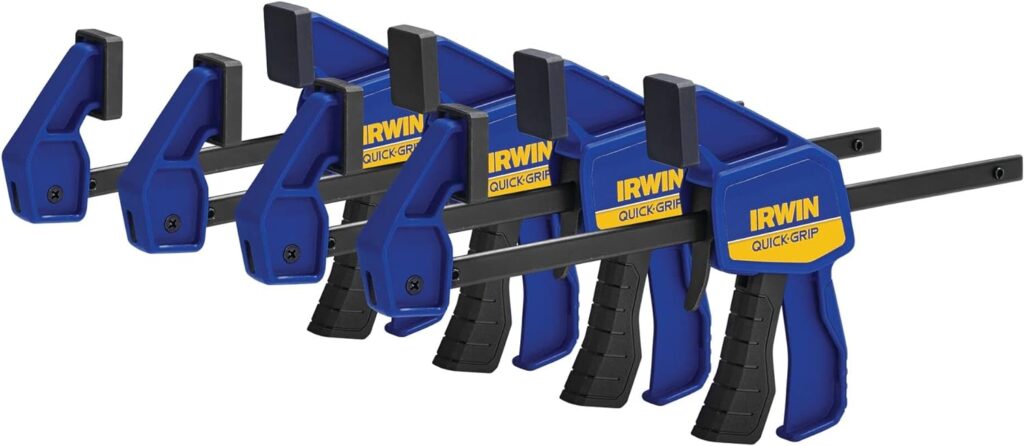Efficiency is key when it comes to woodworking projects. Having the right clamps can make a significant difference in your workflow. In this beginner’s guide to clamps, we will explore the various types and sizes of clamps available. With recommendations for building up an initial clamp collection. From pipe clamps for those big jobs to F-clamps for everyday tasks. Even specialized clamps like band and corner clamps, we will provide expert tips on how to utilize these tools effectively to maximize efficiency in your woodworking projects. Whether you’re gluing up panels, assembling cabinets, or working on smaller odd jobs. The right clamps can streamline your workflow and enhance the quality of your projects.
Selecting the Right Clamps for the Job
Matching Clamp Types to Woodworking Tasks
While woodworking projects vary in complexity, having the right clamps for the job can make a significant difference in efficiency and precision. It’s crucial to match the type of clamps you use to the specific woodworking tasks at hand. For instance, pipe clamps are excellent for panel glue-ups and carcass assembly. While parallel-jaw clamps provide more reach and pressure for heavy-duty projects. After determining the typical tasks you undertake, you can build a well-rounded clamp collection that meets your woodworking needs.
| For Panel Glue-Ups and Carcase Assembly | Pipe Clamps |
| For Lighter Weight Projects | Sash Clamps |
| For Heavy-Duty Pressure and Flat Panel Results | Parallel-Jaw Clamps |
| For Bench Work and Everyday Tasks | F-Clamps |
| For One-Hand Operation and Quick Adjustments | Quick Grip Clamps |
| For Detail and precision Clamping | Spring Clamps |
Assessing Clamp Quality and Durability
In the quest for efficient woodworking practices, it’s crucial to assess the quality and durability of the clamps you choose. With different clamp types available, each offering unique features and benefits, it’s crucial to invest in clamps that will provide long-lasting performance. With hand screws, for example, you have the advantage of deep reach and the ability to cant the jaws out of parallel for added versatility. By prioritizing quality and durability in your clamp selection, you can enhance your woodworking experience and achieve superior results.
Effective Clamp Placement and Use
Optimizing Clamp Position for Stability and Pressure
Stability and pressure are key factors when it comes to effective clamp placement in woodworking. By ensuring that clamps have a secure footing on a flat surface, such as a bench or table, you can maximize their stability and locking power. Placing clamps closer to the edges of workpieces can provide better pressure distribution. Especially when working on panel glue-ups or carcass assemblies. Taking the time to position clamps strategically can result in a more secure grip and even pressure spread.
Avoiding Common Clamping Mistakes for Better Results
Many woodworkers make common clamping mistakes that can impact the overall quality of their projects. One of the most important aspects to consider is the proper placement of clamps to ensure even pressure distribution. Additionally, avoiding over-tightening clamps can prevent damage to both the clamps and the workpieces. By using the right type of clamp for the job and paying attention to placement and pressure. You can achieve better results and increase the longevity of your clamping tools.
Organization and Storage for Quick Access
Organizing Clamp Collections for Maximum Efficiency
An organized clamp collection is crucial for maximizing efficiency in woodworking projects. By categorizing clamps based on their types and sizes, woodworkers can easily locate the right clamp for the job, saving valuable time during project execution. Utilizing storage solutions such as shelves, racks, or labeled bins can further streamline the process, ensuring quick access to the necessary clamps.
Innovative Storage Solutions for Woodworking Clamps
Clamp collections can be efficiently stored using innovative solutions that maximize space and accessibility. Consider investing in wall-mounted clamp racks or mobile clamp carts to keep your clamps organized and within reach. Additionally, utilizing pegboards or customized clamp holders can help prevent clutter and ensure that each clamp has its designated spot. Enhancing overall workshop efficiency.
Advanced Clamping Techniques
Many woodworkers rely on a variety of clamps to tackle complex woodworking projects efficiently and effectively. Here are some advanced clamping techniques to take your woodworking skills to the next level:
Using Clamps in Complex Assemblies
An important aspect of woodworking is understanding how to use clamps effectively in complex assemblies. By strategically positioning clamps, such as parallel-jaw clamps or aluminum bar clamps with deep jaws. Woodworkers can ensure even pressure distribution and maintain flatness in large panels and assemblies. When working on intricate projects like cabinets or furniture pieces. Having a solid grasp of clamping techniques is crucial for achieving high-quality results.

Creative Uses for Clamps in Specialty Projects
Techniques Understanding the versatility of clamps in woodworking allows craftsmen to explore creative possibilities in specialty projects. From using band or strap clamps for securing irregular shapes to employing corner clamps for precise alignment in frame-making. There are numerous ways to leverage different types of clamps for unique woodworking applications. By incorporating innovative clamp techniques, woodworkers can enhance their craftsmanship and take on more challenging projects with confidence.
Maintenance and Care for Longevity
Routine Cleaning and Inspection of Clamps
Keep your woodworking clamps performing at their best by incorporating regular maintenance into your workflow. With routine cleaning and inspection, you can ensure that your clamps are free from debris and damage that could affect their functionality. Wipe down your clamps after each use to remove any excess glue or dirt, and inspect them for any signs of wear or misalignment.
Wonder Wipes For Tool Cleaning
Formulated to tackle and remove heavy-duty stains, wet and semi-cured paint, sealant, adhesive, bitumen, expanding foam, oil, grease, and silicone from tools, hands, and surfaces.
Repair and Replacement Tips for Woodworking Clamps
Woodworking clamps, like any tool, may require repairs or replacements over time to maintain their effectiveness. If you notice issues such as bent bars or damaged jaws, consider repairing or replacing those components to keep your clamps in top condition. Recognizing when a clamp has reached the end of its lifespan is crucial for maintaining a safe and efficient workshop.
- Woodworking clamps can lose their effectiveness if parts are bent or damaged.
- Recognizing signs of wear and tear early can prevent accidents or errors during projects.
Cleaning your clamps regularly and inspecting them for any issues is important for their longevity. By taking the time to care for your clamps properly. You can ensure they remain reliable tools in your woodworking arsenal. Recognizing when repairs or replacements are necessary can save you time and frustration in the long run.
To wrap up
After exploring the beginner’s guide to clamps, it is evident that having the right assortment of clamps is imperative for maximizing efficiency in woodworking projects. By starting with the recommended clamp types and sizes. Woodworkers can streamline their workflow and tackle a wide range of tasks with ease. From securing project parts during assembly to providing the necessary pressure for gluing. Clamps play a crucial role in achieving professional results. As you expand your clamp collection based on your specific needs and preferences, remember to consider factors like reach, pressure capacity, and versatility. By selecting the appropriate clamps for each task, you can work more efficiently and produce high-quality woodworking projects. With the right clamps at your disposal, you’ll be well-equipped to take on any project with confidence and precision.
The Carpenter’s Mate works with several affiliate programs and as such we may receive a small commission from purchases via links in this article, at no cost to the buyer.
If you found this article helpful why not check out our other guides.







